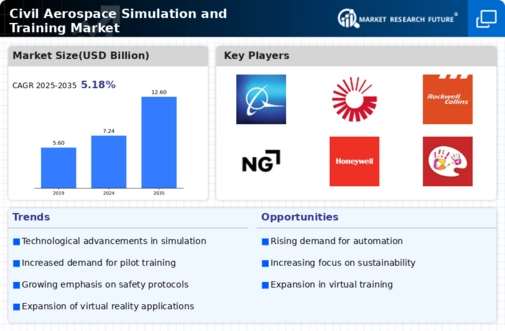Top Industry Leaders in the Civil Aerospace Simulation Training Market

Key Players and Market Dominance:
ECA SA (France),
CAE Inc. (Canada),
Flightsafety International Inc. (US),
Elbit Systems Ltd (Israel),
IndraSistemas SA (Spain),
FRASCA International, Inc. (US),
Thales SA (France),
L3 Technologies, Inc. (US),
United Technologies Corporation (US),
TRU Simulation + Training Inc. (US).
Strategies Adopted for Market Leadership:
To maintain and enhance their positions, key players in the civil aerospace simulation and training market employ diverse strategies. Strategic collaborations, mergers, and acquisitions have become common as companies aim to broaden their service portfolios and expand their global footprint. For example, partnerships between technology providers and aviation companies have facilitated the integration of cutting-edge simulation technologies into training programs. These strategies not only enhance the market reach of companies but also contribute to the overall growth of the industry.
Factors for Market Share Analysis:
Market share analysis in the civil aerospace simulation and training sector is influenced by various factors. Technological innovation and the ability to offer tailored solutions catering to the specific needs of aviation clients are critical determinants. Moreover, factors such as regulatory compliance, safety standards, and the efficiency of training programs play a pivotal role in market share dynamics. Companies that adapt swiftly to regulatory changes and invest in the development of realistic and high-fidelity simulators are better positioned to gain and sustain market share.
New and Emerging Companies:
The civil aerospace simulation and training market has witnessed the emergence of new players, bringing fresh perspectives and innovative solutions. Start-ups and niche players often focus on specialized training modules, virtual reality (VR) applications, and artificial intelligence (AI) integration. These companies, such as Quantum3D and Presagis, are nimble and agile, capitalizing on niche markets and disruptive technologies to carve a space for themselves alongside established players. The entry of new companies contributes to market diversity and encourages healthy competition.
Industry News and Developments:
Staying abreast of industry news and developments is crucial in understanding the competitive landscape. Recent advancements in civil aerospace simulation and training include the integration of immersive technologies like augmented reality (AR) and VR, cloud-based training platforms, and artificial intelligence-driven adaptive learning systems. Companies that invest in these technologies gain a competitive advantage, offering more efficient and cost-effective training solutions. Additionally, news related to contract wins, strategic partnerships, and government collaborations serves as a barometer for a company's market influence.
Current Company Investment Trends:
Investment trends in the civil aerospace simulation and training market reflect the industry's focus on technological advancements and global expansion. Companies are allocating significant resources to research and development, aiming to create state-of-the-art simulation systems that mimic real-world scenarios. Investments in data analytics and AI-driven predictive maintenance solutions are also on the rise, enhancing the overall efficiency of training programs. Additionally, strategic investments in infrastructure and partnerships with airlines, educational institutions, and regulatory bodies contribute to long-term sustainability and growth.
Overall Competitive Scenario:
The overall competitive scenario in the civil aerospace simulation and training market is characterized by a delicate balance between traditional market leaders and the innovative approaches of newer entrants. Established players focus on maintaining their technological leadership and expanding their service offerings through strategic acquisitions. Simultaneously, new and emerging companies leverage niche expertise and agile methodologies to disrupt the market and carve out specialized niches. The evolving regulatory landscape, technological advancements, and the demand for cost-effective and realistic training solutions continue to shape the competitive dynamics of this vital industry.
The civil aerospace simulation and training market represent a dynamic and competitive landscape, driven by technological innovation, strategic partnerships, and a commitment to safety and efficiency. Key players such as CAE Inc., L3Harris Technologies, and FlightSafety International maintain dominance through their global reach and continuous investment in cutting-edge technologies. The influx of new companies introduces fresh ideas and disruptive technologies, contributing to the overall growth and evolution of the industry. Staying informed about market trends, industry news, and investment strategies is essential for understanding the intricacies of this dynamic sector.
Recent News :Top of Form
FlightSafety International have been at the forefront, offering comprehensive training solutions for civil aerospace. These industry giants leverage their extensive experience and global presence to maintain a competitive edge. CAE, for instance, is known for its innovative simulation technologies and strategic partnerships, allowing it to capture a substantial market share.
CAE:
November 15, 2023: Announced it will expand its Dallas/Fort Worth training center with a new Airbus A350 XWB full-flight simulator (FFS), catering to the rising demand for A350 pilots in North America.
October 26, 2023: Partnered with Boeing to develop a first-of-its-kind hybrid training program combining virtual reality (VR) and traditional simulator training for Boeing 737 MAX pilots.
FlightSafety International:
December 19, 2023: Unveiled its new Leonardo AW139 helicopter FFS at its London Gatwick training center, marking its entry into the offshore oil and gas helicopter training market.
September 20, 2023: Launched its "Virtual Reality Ground School" program, utilizing VR technology to enhance the learning experience for initial flight training.
L3Harris Technologies:
January 9, 2024: Received a contract from the U.S. Air Force to provide FFS training devices for the T-6A Texan II aircraft, showcasing its expertise in military flight training solutions.
November 8, 2023: Announced a partnership with CAE to collaborate on the development and marketing of next-generation virtual and augmented reality training devices for the civil aviation industry.


